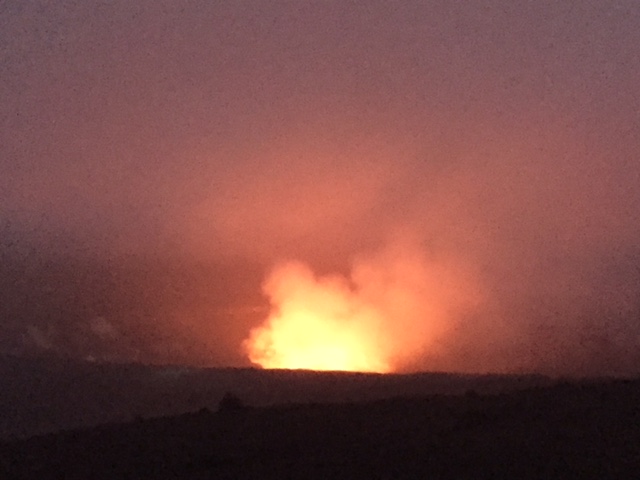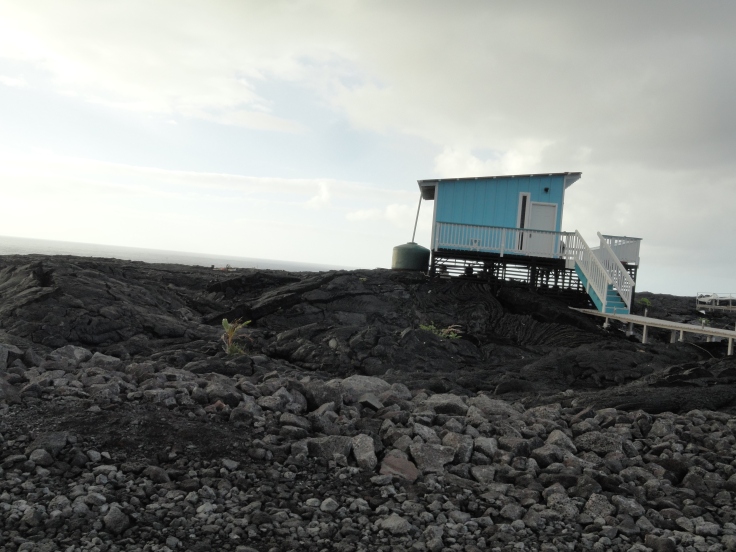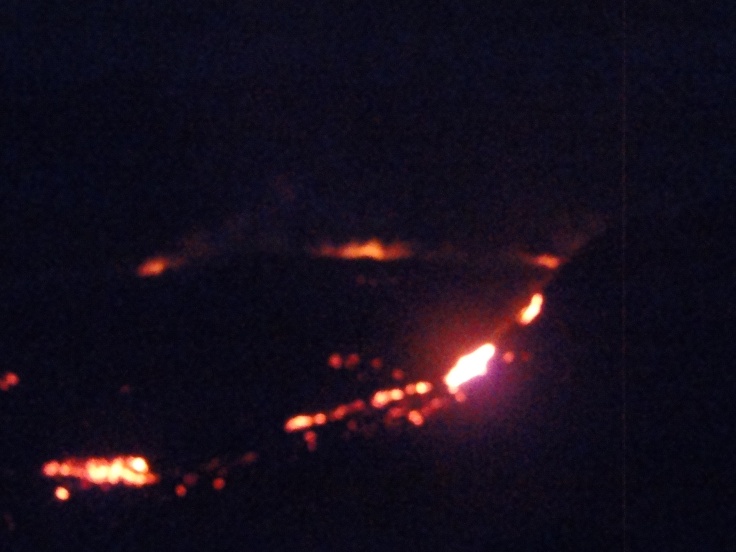In this painting by artist, Herb Kawainui Kane, titled Pele Honua Mea, or Pele of the Sacred Earth, displayed at the Jaggar Museum at Hawai’i Volcanoes National Park, we see one of his interpretations of Pele personified. Mr. Kane is an artist-historian and author.
“Months later Ranger John Erikson called from Hawaii Volcanoes National Park, asking me to participate with their designers on a new museum about Hawai’i’s volcanoes. It had been conceived as a scientific museum, but something seemed missing; science alone could not express the human experience of the volcanoes.” ~Herb Kawainui Kane in Pele, Goddess of Hawai’i’s Volcanoes
The power of Pele is persuasive, pervasive, penetrating; especially in lower Puna. Pele is the Hawaiian Goddess of the Volcano. She has the power to destroy and create. It is said that she calls us to her. Many come here to lower Puna during transitional times in our lives, to let go of the old and create new beginnings. There is much mythology here about Pele, originally told in chants and hula, in order to aid the memorization of the oral histories before the stories were written down. A newcomer might be skeptical, but once you’ve been here awhile, looked into the crater, seen the lava flow, and attended local events with those who’ve experienced this land longer, you too begin to feel the power of Pele. If you haven’t been here, come and see for yourself.
We first saw the glow of the lava from the Kilauea Caldera at Volcanoes National Park. The park is beautiful with lots of trails and informational signs. There is a visitor center, an art museum, the Jaggar Museum near the crater, and the Volcano House lodge. There are rooms to rent and restaurants at the lodge. In the restaurant there is a huge window for indoor viewing. During the daytime you can see the steam above the caldera from quite a distance.

On first viewing, we were filled with awe and Pele drew us closer until we were as close as we could get at the viewing site outside the Jaggar Museum. We couldn’t wait until dark.
While we waited, we hiked the Sulfur Banks Trail, where steam can be seen above fissures in the earth, from a boardwalk path. Then, we drove a short way to the Thurston Lava Tube. We joined a big crowd of tourists speaking a variety of languages, to hike down into the cool, damp lava tube, overgrown with ferns. It’s a gorgeous walk. We had a traditional Hawaiian lunch at the lodge, and waited for dark. When the sun began to set, the lava began to glow, and its intensity deepened, the darker it got. We braved the rain and stood, mesmerized, “oooing and ahhhing,” at every spit and spurt of the boiling lava. We felt like we were looking into the center of the live earth. It was hard to tear ourselves away.
Two days later, a friend at Kalani, Keith, offered to drive us and another friend, Siham, to view the lava flow. Kilauea is a shield volcano, and the lava comes up from inside and seeps out of cracks and flows downhill to the ocean. Through the years there have been many flows, in different directions down the hill. Sometimes the flows have destroyed houses and communities. One flow covered the road that went around the southern part of the island. Evidence of fresh cooled lava is everywhere here, some smooth, some chunky, some turned into black sand beaches. But, very near Kalani, a half hour by car, the lava is currently flowing and it is irresistible to go see it. This is true no matter how many “danger, stay away, you will die” signs block the path. There is a whole tourist area set up with security and bikes to rent to ride past where you’re allowed to park. There is lava rock road much of the way. Once you find a place to park, you can ride a bike or hike about four miles, round trip to get a good view. You can hike down toward the ocean and watch from a cliff as the lava meets the sea with much spattering and steam. Or, you can walk up the mountain to where the lava is streaming slowly, “so close you could touch it.” Another option is you can hire a boat, for $220, to take you right in front of the lava as it pours into the ocean.
Keith took us at 4 A.M., on the full moon in October, to the end of the road, past where security stops you later in the morning. We went past where the bikes were for rent. We parked in an area where adventurous types build their houses on the frontier of the barren recent flows. They live out there, off the grid, where it seems the cooled lava could break off at any time and fall into the ocean as it has done in the past. They collect rainwater, use solar, and often rent their spaces out through Airbnb.

We started walking fast in the windy, sometimes rainy, predawn. We walked and walked and walked. Then we ran out of road, and hesitatingly tested our footing on the ragged, chunky lava rock. Using flashlights to place our feet, we stepped gingerly onto the spongy, crunchy, weirdly sparkly lava. Keith forged quickly ahead, Matt followed. Siham and I followed reluctantly. We were fine until we imagined the rock under our feet was hot, bent down, and found it to be literally hot to the touch. Our survival instinct kicked in, and we were paralyzed with fear. And, I may be a pretty cautious person, but Siham just biked three months across the U.S. by herself. We froze and contemplated death by burning lava, or cracking lava flow falling into the ocean, for quite a while before Siham came up with the chant, “Don’t stop, don’t think.” Holding on to each other, we proceeded, until we caught up with the guys. When we finally could see over the cliff where the lava splashed dramatically into the ocean with fountains of glowing lava and hissing steam; we stood in awe, giggling, and taking all kinds of pictures; but refusing to take one more step than we had to. Any step could be the fragile spot that breaks through into the liquid lava. We could see the chunks of lava build up and break off unpredictably as it snaked its way down the cliff.


Keith, however, was exploring all over and found a crack in the black lava rock where he could see red below. He called us over, with all kinds of convincing encouragement. He jumped on the rock to show it was stable. We finally joined him at the spot, and did indeed, see the flowing lava through a crack in the rock.

That was enough risking our lives for one day. Siham and I wanted to rush back to where the rock was at least cool under our feet. But, once again, we were talked into risking our lives just a little bit longer to witness the beautiful sunrise, on a full moon morning. What an experience. It was exhilarating, awesome, and indescribable.







Leave a comment